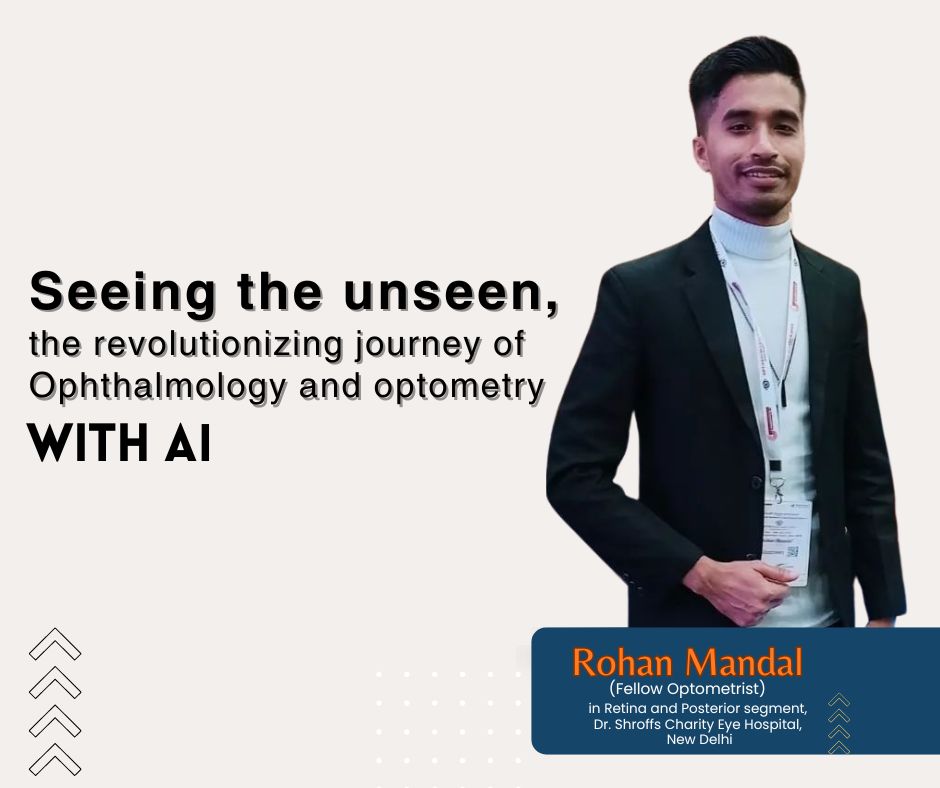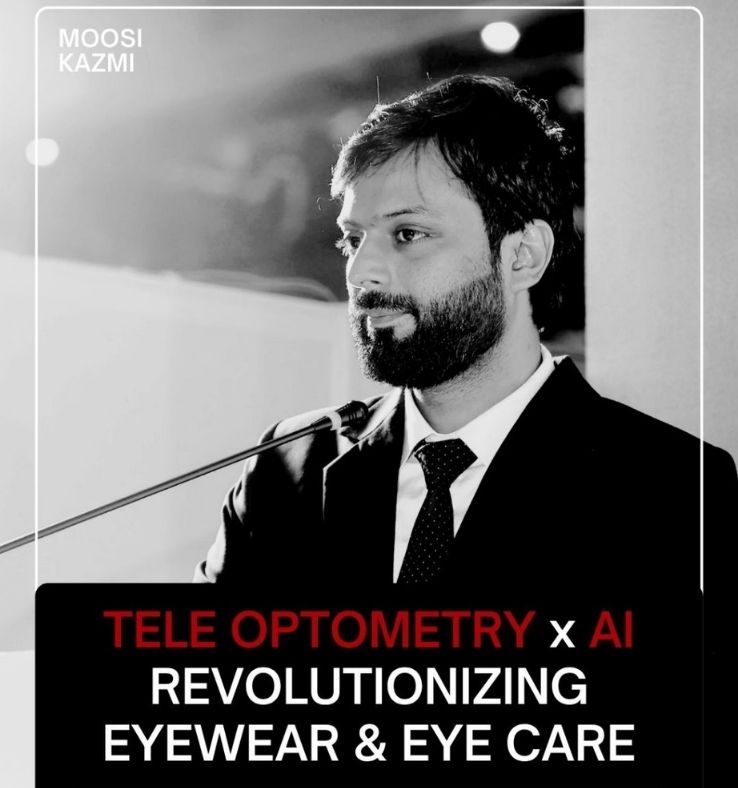Seeing the unseen, the revolutionizing journey of Ophthalmology and Optometry with AI

Certainly, Artificial Intelligence is rapidly growing appliance that already proved as an emergent tool in several fields. Now by the assistance of AI we can operate the unattainable corner of various fields.
In ophthalmology and Optometry, AI has evolved as a tremendous impact. With evidence now AI clearly can enhance how to access patients towards their clinical screening, easily diagnose any kind of abnormality to the management part(1).
 |
Now here some resource how AI can change the fields:
Early detection and diagnosis – AI algorithms can detect and analyze retinal diagnostics images like fundus photo, (OCT) scans as well as fundus autofluorescence. AI can able to manage eye screening on a large population. Previously published paper on the International Journal of Ophthalmology, established an important comparison on AI to detect clinical findings and accuracy of various eye diseases: (2)
: Age related macular degeneration - 75 to 100 %
: Cataract – Over 70 %
: Glaucoma – 63.7 % to 93.1 %
: Non proliferative diabetic retinopathy (NPDR) – 75 % To 94.7 %
: Proliferative diabetic retinopathy (PDR) – 75 % to 91 %
: Retinal vein occlusion – Over 97 %
: Retinopathy of prematurity (ROP) – Over 95 %
Personalized treatment plans – In some disease of various patients there also may be present different systemic conditions. So, AI can evaluate a particular patient’s potential risk for developing various disease by based on their systemic conditions, lifestyles, and genetic factors. By the same way AI can create personalized treatment plans of different patients by analyzing a patient’s medical data, systemic condition, and their unique needs.
Telemedicine and remote monitoring – After the Covid – 19 pandemic the impersonation of telemedicine in medical field is become highly beneficial. Among them Ophthalmology may be the most benefited one.
The actual meaning of Telemedicine means medicine from a distance. Subsection of telemedicine, teleophthalmology is become emergent tool by using AI. (3) (4). Here below the two methods of teleophthalmology shown in figure 1 below
So, by using AI teleophthalmology is much more benefitted by eliminating the distance. (5) It helps also by reducing the waiting time and the risk of infections. Disease like DR, ARMD, Glaucoma, Cataract and ROP now can be diagnosed easily and can be effectively monitored by the application of AI. (6)
Enhancing surgical precision – In some surgical process AI works as a tremendous role. Now by using AI we can plan personalize surgical plan for refractive surgery. By analyzing data from corneal topography and from other tests we can do optimal treatment plan for better visual outcomes and we can also manage the complications.
In Lasik refractive surgery we use a femtosecond laser, that create flaps. So, in this process now AI can adjust the laser parameters according to flap size. (7)
Streaming and administrative task – Now AI can manage every patient’s data with more accuracy. If in long term follow up visit, we just need to know one important data from last 10 years visit. By using AI on EMR the important data would be highlighted automatically. (8)
Now AI can fix any schedule or follow up plan, billing by itself by analyze the previous plan of management. For any emergency help patient can get service of every time.
Research and drug development – By using developing AI on image based clinical investigations now we can do more crucial work of study and research. Many researchers in ophthalmology now start using deep imaging methods to perform high dimensional analysis. Disease like DR, Glaucoma, ARMD, Cataract and other anterior segment which need high accuracy in image analyzing now become more accurate. Using AI algorithms and analyze every patient’s data from huge populations as well as various community it can now become more easier to produce potential drug for particular patient.
While AI offers immense potential but there also has some challenges and ethical considerations.
Conclusion – The artificial Intelligence into Ophthalmology and Optometry is revolutionizing the way we approach eye care. From early disease detection to personalized treatment plans AI enhancing the way.
As technology continues to evolve, we can apply even more exciting developments of AI that can shape the future of Ophthalmology and Optometry. But that connection and efforts of an eye care professional and between a patient, their emotion plays a role in recovering. These connections, these bonds cannot never be replaced by AI.
References:-
1. Keskinbora K, Güven F. Artificial Intelligence, and Ophthalmology. Turk J Ophthalmol. 2020 Jan;50(1):37–43. doi: 10.4274/tjo.galenos.2020.78989. [PMC free article] [PubMed] [Google Scholar]
2. Ting DSW, Cheung CY, Lim G, et al.. Development and validation of a deep learning system for diabetic retinopathy and related eye diseases using retinal images from multiethnic populations with diabetes. JAMA 2017;318:2211–23. 10.1001/jama.2017.18152 [PMC free article] [PubMed] [CrossRef] [Google Scholar]
3. Ajami S, Lamoochi P. Use of telemedicine in disaster and remote places. J Educ Health Promot. 2014;3:26. [PMC free article] [PubMed] [Google Scholar] Retracted
4. McLean S, Protti D, Sheikh A.Telehealthcare for long term conditions BMJ 2011. Feb 3342d120. [PubMed] [Google Scholar]
5. Grisolia A.B., Abalem M.F., Lu Y., Aoki L., Matayoshi S. Teleophthalmology: Where are we now? Arq. Bras. Oftalmol. 2017;80:401–406. doi: 10.5935/0004-2749.20170099. [PubMed] [CrossRef] [Google Scholar]
6. Abramoff M.D., Leng T., Ting D.S.W., Rhee K., Horton M.B., Brady C.J., Chiang M.F. Automated and computer-assisted detection, classification, and diagnosis of diabetic retinopathy. Telemed. J. e Health. 2020;26:544–550. [PMC free article] [PubMed] [Google Scholar]
7. Moya T, Javaloy J, Montes-Mico R, Beltran J, Munoz G, Montalban R. Implantable collamer lens for myopia: assessment 12 years after implantation. J Refract Surg. 2015;31(8):548–556. doi: 10.3928/1081597X-20150727-05 [PubMed] [CrossRef] [Google Scholar]
8. Goyal A., Gluckman T. J., Tcheng J. E. What’s in a name? Circulation. 2017;136(13):1180–1182. doi: 10.1161/ circulationaha.117.030347. [PubMed] [CrossRef] [Google Scholar]

.jpg)

.jpg)
.jpg)
.jpg)


1.jpg)



.jpg)
.jpg)



_(Instagram_Post).jpg)
.jpg)
_(1080_x_1080_px).jpg)


with_UP_Cabinet_Minister_Sh_Nand_Gopal_Gupta_at_OpticsFair_demonstrating_Refraction.jpg)
with_UP_Cabinet_Minister_Sh_Nand_Gopal_Gupta_at_OpticsFair_demonstrating_Refraction_(1).jpg)

.jpg)








.jpg)



.png)




